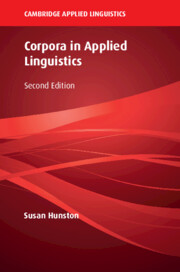Book contents
- Corpora in Applied Linguistics
- The Cambridge Applied Linguistics Series
- Corpora In Applied Linguistics
- Copyright page
- Dedication
- Contents
- Figures
- Tables
- Acknowledgements
- 1 Introduction
- 2 Designing a Corpus
- 3 Learning from a Corpus
- 4 Foundational Quantitative Concepts in Corpus Linguistics
- 5 Exploring Corpora through Quantitative Measures
- 6 The Language Learner and the Corpus
- 7 Corpora and the Analysis of Discourse
- 8 Further Applications of Corpus Research
- 9 Corpora and Language Theory
- 10 Conclusion
- References
- Index
- References
References
Published online by Cambridge University Press: 21 April 2022
- Corpora in Applied Linguistics
- The Cambridge Applied Linguistics Series
- Corpora In Applied Linguistics
- Copyright page
- Dedication
- Contents
- Figures
- Tables
- Acknowledgements
- 1 Introduction
- 2 Designing a Corpus
- 3 Learning from a Corpus
- 4 Foundational Quantitative Concepts in Corpus Linguistics
- 5 Exploring Corpora through Quantitative Measures
- 6 The Language Learner and the Corpus
- 7 Corpora and the Analysis of Discourse
- 8 Further Applications of Corpus Research
- 9 Corpora and Language Theory
- 10 Conclusion
- References
- Index
- References
- Type
- Chapter
- Information
- Corpora in Applied Linguistics , pp. 307 - 333Publisher: Cambridge University PressPrint publication year: 2022

